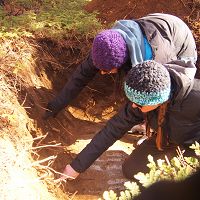Researcher Spotlight: Russell Callahan
Researchers from Southern Sierra Critical Zone Observatory work in a variety of disciplines and come from many different backgrounds. They all have their own story to tell. Take a look at this month's researcher spotlight Russell Callahan, PhD Student at the University of Wyoming, and learn about his work in the field of critical zone science! Russell Callahan applies a combination of geophysics and regolith geochemistry to understand landscape evolution and regolith thickness.
Q&A between Madeline Castro and Russell Callahan
What is your field of interest/research? How did you become interested in this topic?
I would broadly describe myself as a hillslope geomorphologist, although I use a variety of tools including near-surface geophysics, geochemistry, and remote sensing to answer questions about the critical zone. I became interested in the critical zone during my undergraduate degree. As an undergraduate I was able to participate in a REU program at Hubbard Brook Experimental Forest. During the REU I spent a lot of time walking around the woods digging soil pits. After my REU I continued doing undergraduate research in soils and eventually decided I was interested in going to graduate school to study geomorphology.
What CZOs have you conducted research at? What kinds of research did you do there?
So far, I have only worked at the Southern Sierra CZO, although I hope to have the opportunity to work at other CZOs sometime in the future. At the SSCZO my work has focused on how subsurface Critical Zone (CZ) thickness and structure influences geomorphic processes like hillslope erosion and river incision, as well as ecological processes like ecosystem productivity and drought mortality. I really enjoy this work because it uses a variety of techniques to understand critical zone evolution over varying spatial scales and timescales.
What do you feel is the most exciting part of your research?
I think the most exciting part of my research has been using near-surface geophysics to understand how slight differences in lithology control subsurface CZ structure. Using seismic refraction surveys has allowed me to understand subsurface structure on the hillslope scale. These surveys also allow us to estimate porosity and water-storage capacity. These results have led to new insights on how deep CZ water storage influences ecosystem productivity and resilience to drought across slight changes in lithology.
Why is your field of study important?
My field of study is important because it helps us understand how ecosystems will respond to climate change. Our results suggest that under a changing climate specific areas may be more resilient to mortality and act as refugia during drought related disturbances. Additionally, our measurements of subsurface storage can help understand how water moves through the critical zone. This is especially important in the Sierras which provide water to much of the population of California.
What you are most proud of in your research and/or academic/career experiences?
During my academic experience I have enjoyed presenting my work at conferences. Sharing results of my research with other scientists who are working on similar problems is a very rewarding experience.
What is your favorite part of the Critical Zone (soil, water, rock, etc.) and why?
My favorite part of the critical zone is rock because it sets the template for the rest of the critical zone components. As rock is chemically and physically altered it is converted to saprolite and soil, which provide nutrients and water storage capacity to plants. In some cases, differences in bedrock composition greatly affect the rest of the critical zone.
Photo provided by Russell Callahan
Photo provided by Russell Callahan
Photo provided by Russell Callahan
News Category:
RESEARCH |
PEOPLE |
EDUCATION/OUTREACH
People Involved
CZO
-
Sierra, UNDERGRAD
-
Sierra, GRAD STUDENT
-
Sierra, STAFF
Publications
2017
Mountain erosion over decades and millennia: New insights from sediment yields and cosmogenic nuclides. Callahan, R. P.; Riebe, C. S.; Ferrier K. (2017): Fall Meeting, American Geophysical Union, December 2017. Abstract EP33C-1950.
2017
The influence of subsurface porosity and bedrock composition on ecosystem productivity and drought resilience in the Sierra Nevada Batholith, California . Riebe, C. S.; Callahan, R. P.; Goulden, M.; Pasquest, S.; Flinchum, B. A.; Taylor, N. J.;. Holbrook S. (2017): Fall Meeting, American Geophysical Union, December 2017. Abstract EP53D-1762.
Discipline Tags and CZOs
Geomorphology
Geophysics
Soil Science / Pedology
Outreach / Education Research
Hydrology
Geochemistry / Mineralogy
Sierra
Related News

Researcher Spotlight: Caitlin Collins
13 Mar 2018 - Meet the minds behind the data! Caitlin specializes in modeling water fluxes from drop to catchment scale, tracking water through the Critical Zone.

Researcher Spotlight: Kimber Moreland
18 Jan 2018 - Meet the people behind the research!

Critical Zone Profiles - Meet the people doing CZO science (Southern Sierra CZO)
07 Sep 2015 - Get a sense of the people and the work. Several members of the Southern Sierra CZO are profiled here, including students and professors.

Critical Zone Profiles - Meet the people doing CZO science (Graduate Students)
27 Mar 2016 - Get a sense of the people and the work. Some of the 100+ CZO graduate students are profiled here.

Critical Zone Profiles - Meet the people doing CZO science (Early-Career)
23 Mar 2016 - Get a sense of the people and the work. Several early-career scientists that were students at one of the CZOs are profiled here.

Critical Zone Profiles - Meet the people doing CZO science
27 Mar 2016 - Get a sense of the people and the work. See links to 35+ individual profiles across the network.
Explore Further







